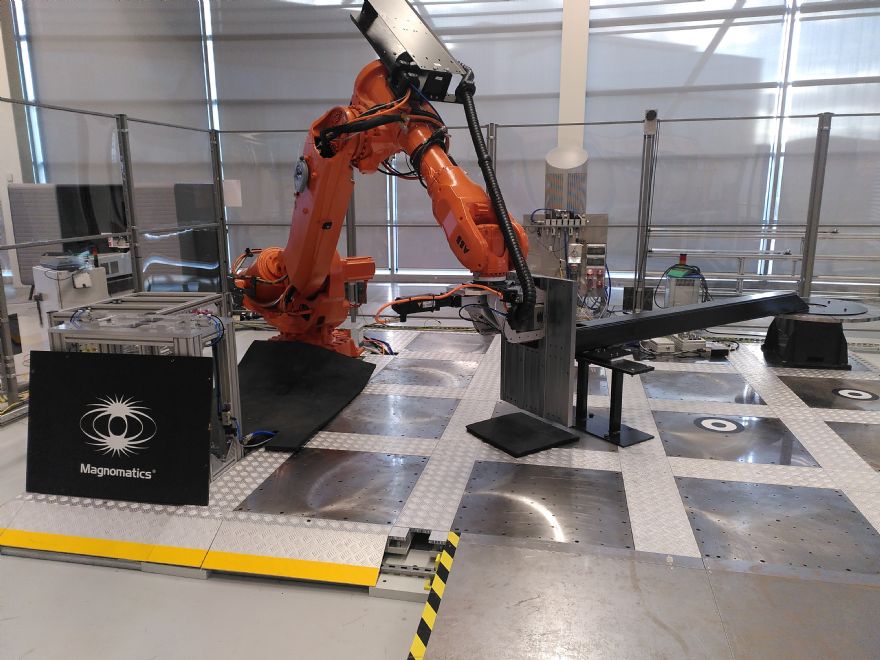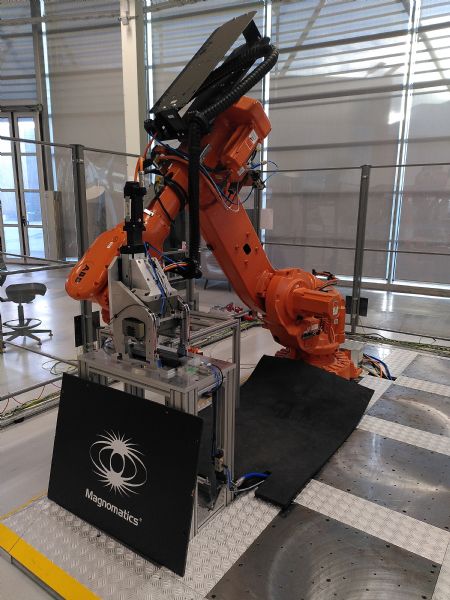
A labour-intensive process to position powerful permanent magnets onto large generators for offshore wind applications has been made 60-times faster by automation experts at the
University of Sheffield AMRC, cutting down the cycle time significantly from 1hr to just 55secs for each magnet.
Magnetic gear technology company
Magnomatics wants to explore how robotic technologies can optimise the manufacturing process and drive big productivity improvements for its wind turbine generators, which form part of its Pseudo Direct Drive (PDD) generator technology portfolio.
The company teamed up with engineers at the AMRC’s Factory 2050 to automate its current manual process which involves operators painstakingly placing 204 large magnets - each weighing 18kg and capable of generating a magnetic force of up to 3kN - using jigs and lead screws to carefully slide the magnets into position, taking up to an hour for each magnet.
The ROBOMAG project, led by the AMRC’s Dr Alexei Winter, uses cutting edge robotics technology to hugely speed up the process - taking less than a minute to place a magnet.
Dr Winter said: “By creating a practical demonstration of robotic magnet placement we are able to show the huge gains to be made by Magnomatics - and there is potential to reduce the time even further. What this project does is allow Magnomatics to better understand how the process can be automated in the future to facilitate the growth of its wind turbine generator manufacture.”
Magnomatics chief executive Dave Latimer said: “We are delighted with the outcome of this project. It is just one element of a series of developments all aimed at manufacturing large direct-drive generators for wind here in the UK. This project places Magnomatics on the right track to develop bigger generators and attract big offshore wind OEMs to Sheffield and the UK.”

Magnomatics, a University of Sheffield spin-out, was one of seven companies to win funding last year from the Offshore Wind Growth Partnership (OWGP) in a call for projects developing advanced manufacturing solutions to improve competitiveness in the offshore wind supply chain.
ROBOMAG is specifically aimed at helping solve the challenge of placing large permanent magnets on a generator hub.
Andrew Macdonald, programme director for the Offshore Wind Growth Partnership, said: “Following a very competitive process, ROBOMAG is one of the first-ever supply chain improvement projects to be funded by OWGP.
“It is a brilliant example of our innovative supply chain in action, supporting the UK to be cost-competitive through advanced manufacturing techniques - a key step in anchoring offshore wind manufacturing activity in the UK and maximising our world-leading position in offshore wind.”
UK offshore wind already powers the equivalent of 4.5 million homes annually and the Government has pledged to power every home in the UK with electricity from offshore wind by 2030, making it a cornerstone of its Ten Point Plan for a green industrial revolution to encourage private investment and double jobs in the sector.
Magnomatics is currently involved in implementing the next stage of scaling-up for offshore wind with a large industrial development partner, scaling up to 5MW or greater for the next step towards a 15MW-plus machine.
The company has worked with manufacturing partners, who did not have the capability to produce large permanent magnet generators, to develop prototype machines and manual processes to complete the build. The major challenge is to be cost-competitive but without automating some of the processes involved in constructing a large generator, it will be difficult to reach commercial acceptance.
In addition to reducing the rotor build time and personnel safety, the ROBOMAG project greatly reduces the need for bespoke tooling, consequently reducing process cost. The cell can be programmed to build new rotors and different magnets combinations, resulting in faster manufacturing process development throughout Magnomatics’ scaling-up process and machine build.
The ROBOMAG project was carried out within the reconfigurable automation cell at the AMRC’s Factory 2050, an accurate reconfigurable platform that allows for different robots, fixtures and machinery to be easily integrated and reconfigured, vastly reducing set up time and complexity.
Dr Winter explained that the current process is difficult and lengthy due to the sheer power of the magnets when placed near the steel hub, taking time to precisely position each magnet. It also poses a potential danger to the operators because of a trapping hazard if the magnets ‘snap’ into place.
He said: “The process risk and its implications to manufacturing cost and capacity are clear. bbWhat we have done is develop and de-risk an automated process that can replace Magnomatics’ current method for mounting permanent magnets onto its electrical machines.
“This not only allows an increase in production rates but also reduces the potential hazards to operators.”